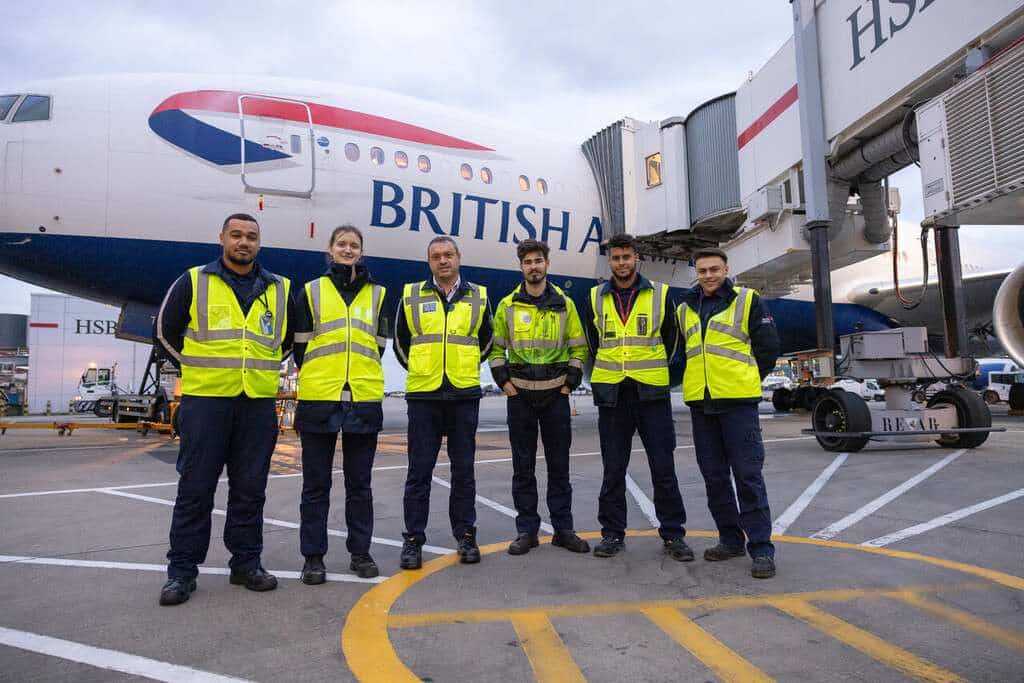British Airways has embarked on a substantial investment program aimed at revolutionizing its ground support equipment at Heathrow Airport.
This move aligns with the airline’s commitment to reducing emissions both in the air and on the ground.
The Overhaul: A Gradual Transition
British Airways will gradually replace its ground vehicles at Heathrow, such as vans, cars, cargo transporters, and passenger steps. It will transition to hybrid or electric alternatives where possible.
Currently, over 90% of the airline’s vehicles and ground equipment at Heathrow are either zero-emission electrical equipment, hybrid, or operate on hydrotreated vegetable oil (HVO) fuel.
Ground Equipment
The airline will replace 750 pieces of ground equipment, including fuel bowsers, with HVO fuel alternatives.
This interim measure is expected to save more than 6,000 tonnes of CO2 per year. This is equivalent to over 8,000 round-trip economy passenger journeys between London Heathrow and JFK.

Replacing all diesel passenger aircraft steps with electric alternatives will mean a significant emissions reduction. We can cut CO2 emissions by over 370 tonnes per year by reducing fuel consumption.
This is equivalent to more than 500 round-trip economy passenger journeys between London Heathrow and JFK.
Cargo vehicles
The airline will phase out 20 diesel-powered vehicles used for loading and unloading cargo containers, and replace them with Hybrid Electric models.
The upgrade will introduce 135 new electric baggage tugs, accounting for 40% of the airline’s tugs, to transport customers’ luggage.
These tugs use highly efficient lithium-ion battery technology, producing 30% less CO2 compared to traditional lead-acid batteries.
Passenger Transport
Over the next two years, British Airways will phase out all 38 diesel passenger buses. Of these, 23 will be converted to fully electric operation, while the remaining 15 will run on HVO fuel.
The airline achieves a double benefit by making this change. It will reduce negative air quality impacts around Heathrow and save 800 tonnes of CO2 emissions per year.

British Airways Comments
Tom Moran, British Airways’ Director of Heathrow, emphasized the airline’s commitment to reaching net-zero emissions by 2050 or sooner. British Airways’ investment is the largest in more sustainable airport ground operations.
“This major investment into our vehicles at Heathrow is our largest investment in more sustainable airport ground operations to date. It is part of our wider environmental objective to minimise emissions from our airside ground operation,” said Moran.
Carrie Harris, British Airways’ Director of Sustainability, expressed pride in this project, driven by the Heathrow ground operations teams and encapsulating the airline’s “BA Better World” ethos.
“Their energy, enthusiasm and innovative approach in bringing the project to life shows what can be achieved,” said Harris.
“Furthermore, this investment demonstrates the airline’s ongoing commitment to making improvements that will benefit both customers and colleagues.”
Conclusion
These improvements form part of British Airways’ £7 billion investment in transformation across many aspects of its business over the next three years.
They also build on previous ground improvements made by the airline. This involves the introduction of electric and hybrid cars for airside-based colleagues.
The initiative will use remote-controlled pushback vehicles for short-haul aircraft, and ensure aircraft plug into electricity at Heathrow when on stand.

Click the banner to subscribe to our weekly newsleter.

Click the photo to join our WhatsApp channel so then you can stay up to date with everything going on in the aviation industry!







